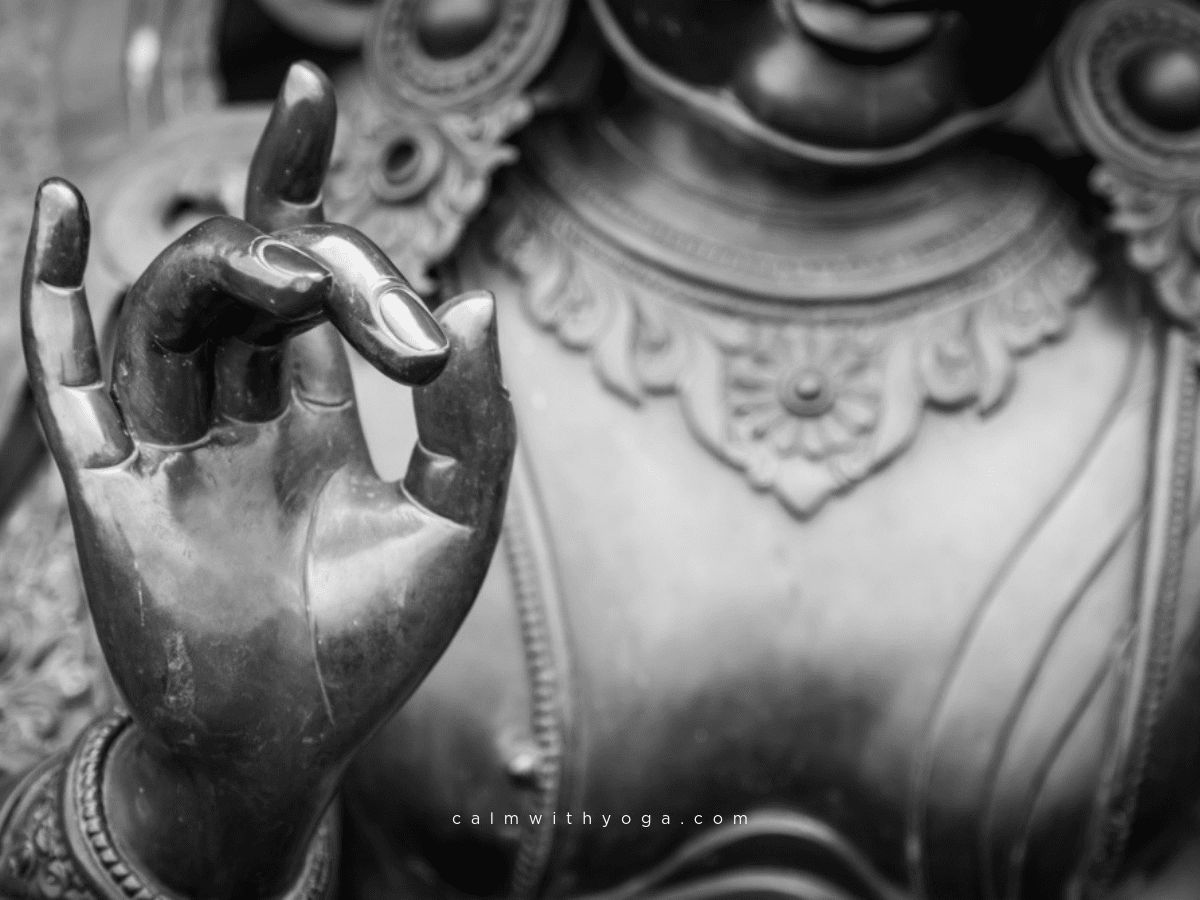Yoga is seeing life the way it is. – The Yoga Sutras of Patanjali
I first began the practice of yoga over a decade ago.
Since then yoga has helped me cope with things like anxiety, depression, insomnia, illness, bad break-ups, and even a miscarriage.
Like most, my entryway was the physical aspect of yoga (hatha yoga.)
Each time I went to a yoga class I experienced the “yoga high” that resulted from the blending of mindful body movement, intentional breathing, and conscious awareness.
I was hooked.
And like any good addict, I wanted more of that high.
So I registered for a 200-hour yoga teacher training with the intention of deepening my practice in order to manage my anxiety and insomnia better.
It was there that I discovered that the physical practice of yoga was just the tip of the iceberg.

There, underneath the surface, was a whole new way of experiencing what yoga truly is… a system and a discipline for mental and emotional mastery.
This system (commonly known as “The Eight Limbs of Yoga” or “The Eightfold Path“) was created thousands of years ago to help still the ripples of the mind and quiet the mental noise that prevents us from fully experiencing life as it truly is.
While the asanas (yoga poses) focus mainly on the body, the eight limbs focus on transforming suffering by disciplining the senses.
Practicing this eight-limbed yoga can help you:
– Awaken deeper understanding, insight, & intuition.
– Cultivate the quality of calm inner balance regardless of outer circumstances.
– Grow inner strength and resilience.
Patanjali’s Yoga Sutras: A Quick Overview

This is the teaching of yoga.
Yoga is the cessation of the turnings of thought.
When thought ceases, the spirit stands in its true identity as observer to the world.
Otherwise, the observer identifies with the turnings of thought.
– Yoga Sutras of Patanjali, Book 1, Sutras 1-4
Thousands of years ago a wise sage known as Patanjali was the first to systemize and summarize the ‘big picture’ of yoga philosophy and yoga psychology.
He wrote The Yoga Sutras to outline how one can experience what scholar Dr. Barbara Stoler Miller called “a complete psychological transformation through the discipline of yoga.” (1)
This ancient text, composed of 195 sutras or little pearls of wisdom, can be considered a guide for creating a meaningful and purposeful life.
From a yoga history perspective, Patanjali’s teachings constitute what is known as Classical Yoga.
31 out of the 195 sutras outline the eight limbs, which are also known as ‘ashtanga yoga.’ (‘Ashta‘ means eight in Sanskrit, and ‘anga‘ means limb.)
The eight limbs of yoga are also known as ‘Raja Yoga.’
‘Raja’ means king in Sanskrit, which is why Raja Yoga is also referred to as ‘Royal Yoga.’
Just as a king maintains dominion over his kingdom, we too must learn to maintain dominion over our inner kingdom.
Observing the eight limbs takes us on a journey from the outer world to the inner world.
According to Patanjali, lasting transformation and liberation are achieved only by accessing this sacred internal space.
The first four limbs are outwardly focused while the last four are internally focused:

Let’s discuss each one in more detail…
Understanding the Eight Limbs of Yoga

Imagine looking at a big tree in its entirety, complete with all of its roots.
These roots anchor the tree firmly into the ground and help create a stable and strong foundation from where it can grow taller and taller, higher and higher.
You may have heard of the phrase “as above, so below; as within so without.”
It applies perfectly to the tree example and the eight limbs.
The first four limbs provide us the roots and a sturdy foundation with which to anchor ourselves in preparation for growth and ascension. (as above, so below)
As we progress through each limb we start to realize that our inner world (the world of our thoughts, emotions, memories, perceptions, and beliefs) creates our outer experience. (as within, so without.)
The 8 Limbs are:
1- Yamas – Self-regulating behaviors
The first limb, the Yamas, is all about how we interact with others and with ourselves.
There are a total of five Yamas:

#1 – Ahimsa:
Typically regarded as non-violence and non-harm, ahimsa can also be understood as the practice of benevolence.
Because our inner world creates our outer world, it’s important to note here that in order to truly practice this first Yama we must first direct our focus to ourselves.
Are we cultivating self-compassion?
Are we as understanding and nurturing with ourselves as we are with others?
Do we wish ourselves loving-kindness and good intentions?
#2 – Satya:
This is the principle of practicing truthfulness and authenticity with our thoughts, words, and actions.
Can we honor how we truly feel about something or someone?
Do we often say ‘yes’ when we really mean ‘no’?
As researcher and author Brene Brown says:
“If you trade your authenticity for safety, you may experience the following: anxiety, depression, eating disorders, addiction, rage, blame, resentment, and inexplicable grief.”
By practicing Satya we train ourselves to choose growth over safety, and we honor ourselves (and others) in the process.
#3 – Asteya:
Typically known as the yogic principle of “non-stealing,” Asteya also means honoring the balance of give-and-receive.
We don’t take what isn’t ours, and we are mindful of not taking more than we give.
Essentially this is the principle of even-exchange, which ensures we stay in harmony with ourselves and with others.
And imbalance of give-and-receive can lead to chaos, stress, resentment, and separation.
This goes both ways.
It’s equally out of balance to constantly give without being open to receiving.
#4 – Aparigraha:
This one means non-coveting, non-possessiveness, and detachment.
Aparigraha helps us unravel whatever misperceptions, cravings, desires, jealousies, and envy we may harbor internally.
These are all natural human states and emotions, however, the Yogi walking on the eightfold path stays vigilant and aware of how these states may be holding him/her back from progressing on the journey.
#5 – Brahmacharya:
Traditionally, this Yama meant celibacy…
But we’re not in ancient times, sitting atop mountains meditating in the Himalayas all day long.
Loyalty and fidelity in your relationships would be a more modern perspective.
Brahmacharya also can mean self-control and temperance.
It’s the practice of becoming aware of what things add to your life force (vital energy) and what (or who) drains you of your vital energy.
We might then choose to abstain from certain foods, people, environments, behaviors, thoughts, or choices.
For example, if you’re struggling with emotional eating, you can practice Brahmacharya by embracing mindful eating and being aware of your eating patterns.
Brahmacharya can mean eating only one slice of pizza instead of the whole thing or enjoying only 1-2 glasses of wine instead of 3-4.
2 – Niyamas – Personal observances
The second limb of yoga, the Niyamas, help us begin to look at ourselves more deeply.
There are five observances:

#1 – Saucha:
Saucha is the principle of cleanliness and purification.
The entire theme of Patanjali’s eight limbs is purification – of mind, of emotions, of body, and of energy.
We can observe this principle by first ensuring that we keep our bodies and minds clean.
Are we practicing good mental and physical health hygiene?
As kids, we’re taught the importance of good dental hygiene:
“Brush your teeth before bed.”
“Floss every day.”
But what about mental hygiene?

Did you know that having a daily gratitude practice is a good mental hygiene habit according to researchers?
Daily meditation or contemplative practices like mindfulness are also forms of ‘mental flossing.’
We also practice saucha by making sure we keep our guts clean and pure by choosing to eat the right life-giving foods most of the time.
#2 – Santosha:
Santosha means contentment, appreciation, and gratitude, which ties in beautifully to the last observance.
Heartfelt contentment and appreciation for what is as it is can help us experience more things to be grateful for.
This isn’t just some fuzzy-wuzzy observance; it’s backed by science.
Research suggests that gratitude can actually help to re-wire the brain in ways that help to lower depression and anxiety.
#3 – Tapas:

The root of the Sanskrit word ‘tapas’ means: “To glow, to shine, to change, & to transform.”
Tapas is the practice of burning off impurities through the heat of challenge.
By practicing Tapas, you courageously feel the burn and allow it to transform you from the inside out.
Practicing tapas means you learn to override knee-jerk impulses to avoid pain and seek pleasure.
You learn to endure pain, discomfort, challenges, and frustration as a means of purification and transformation.
Honoring the practice of tapas reinforces our self-discipline muscle.
#4 – Svadhyaya:

Svadhyaya is the principle of self-study.
It means to educate yourself and to study/observe yourself.
Essentially Svadhyaya is the practice of self-awareness, self-inquiry, and self-reflection.
If we don’t become self-aware how can we ever change or transform ourselves or our circumstances?
Traditionally, svadhyaya also meant the study of scriptures and sacred texts.
The modern spin on this can include any kind of study that helps you learn more about yourself so you can deepen your own self-understanding.
#5 – Ishvara Pranidhana:

Ishvara Pranidhana is the practice of surrender, dedication, devotion, & faith.
It’s about really embodying a deep trust in the infinite intelligence and creative wisdom of a higher power.
According to Yoga Sutra 1.24, Ishvara is the Supreme Self, “unaffected by any afflictions, actions, fruits of actions, or by any inner impressions of desire or greed.”
Isvara Pranidhana, then, is the devotion and dedication to the full expression of this Supreme Self… of your Supreme Self.
This means that we not only trust the intelligence of a higher power but that we also trust our own innate intelligence and capacity to fully express our potential.
According to Yoga Sutras 1.27-1.28, the word expressive of this Supreme Self (Ishvara) is Om or Aum.
So one way to observe this last Niyama is by meditating on the mantra Om/Aum or even silently repeating it in your mind as a meditative practice.
These last three Yamas (Tapas, Svadhyaya, and Ishvara Pranidhana) constitute what Patanjali referred to as Kriya Yoga (Yoga in action or Yoga in practice.)
3 – Asana – Yoga postures
Asana is the third limb and it refers to the physical postures that help the body prepare for deep meditation.
Patanjali didn’t go into great detail about this limb, but he did mention that asanas should be both comfortable and easy.
It’s thought that asanas postures were originally meant to be held for longer periods of time in stillness.
This is quite different from the faster-paced asana practice of vinyasa flow classes many of us are used to.
4 – Pranayama – Regulation of life force energy via the breath
‘Prana’ refers to the life force/ vital energy flowing in and through everything in the universe.
Prana flows through the subtle energetic channels (nadis, meridians) and also through the seven main energetic centers that run up and down our spines (chakras).
With every breath, prana is absorbed into our bodies.
Our thoughts are also a form of prana, so quieting the mind helps to regulate our internal vital energy.
Ancient yogis might not have had the science to back it up way back when, but they knew that there was a significant connection between breath and emotions.
They knew that we could learn to quiet the mind and soothe moods via breath control.
In Sutras 1.34, Patanjali made it very clear that “calm is retained by the controlled exhalation or retention of the breath.”
According to a growing body of research, a regular pranayama practice offers a host of mental and physical health benefits.
This fourth limb is all about breathing techniques and breathing exercises that can either energize the body, calm the mind, help the body relax, increase sleep, and even boost immunity.
5 – Pratyahara – Withdrawal of the senses
The fifth limb of yoga is all about withdrawing the senses from the outer world and drawing them inward so we can explore and become familiar with our internal landscape.
Up to this point, the focus has been on the exterior – on the other(s), on your body, and then on your breath…
We use the breath as a bridge to access the state of pratyahara, which is the beginning of the internal journey that culminates in spiritual insight and power.
The first four stages or limbs help us refine the parts of our personality that get in the way of us ascending through the rest of the stages.
This first part of our journey is about gaining mastery over the body so that we can cultivate an energetic awareness of ourselves.
Thanks to limbs 1-4 we’re now prepared and have built a strong foundation to ascend to the second part of our journey – the transcendence of the senses and thought so we can access higher states of consciousness.
6 – Dharana – Concentration & focus on a single point
Once the senses are transcended we move onto the sixth limb, which is all about one-pointed focus and sustained concentration.
Dharana is a form of mental training and can involve the use of a focal point such as our breath, a symbol, a candle, or a mantra.
The trick here is not to become fixated on holding the focus forcefully because then we become rigid and miss out on the present moment awareness available to us at this moment.
Instead, allow your focus to loosen and with enough practice and dedication you will begin to flow with your focal point; you’ll begin to merge with it.
A great way to begin practicing Dharana is by cultivating daily mindful breath awareness.
This is how the Buddha taught monks to meditate and you can learn this too if you’re committed and devoted to the path.
Will you jump in and out of focus and become lost in your thoughts again?
Yes, totally.
And this is part of the process.
The trick to Dharana is not to never lose your focus, instead, it’s all about the Return.
Once you notice you’ve drifted off – return your attention to your focal point whether it’s your breath or even a mantra.
7 – Dhyana – Meditation practices
The sixth limb gradually leads to the seventh limb – Dhyana.
This is where a state of deep meditation can be experienced.
In deep meditation, our personality takes a back seat and our atman or soul/spirit takes over.
This is where heart intelligence, intuition, creativity, and inspiration are born.
While we’re in Dhyana, we’re in a place of no time, no space, no name, no past, no future… just pure presence and pure being.
Deep meditation has been attributed to alpha and theta brain wave frequencies, which are associated with higher states of consciousness. (2)
Studies link meditation to changes in the brain.
Such changes offer many benefits: (3)
– helps to slow down the aging of the brain
– helps promote authentic connection and empathy with others
– can alleviate symptoms of anxiety and depression (rivaling the effectiveness of certain drugs)
– improves concentration and attention
– can help to manage addictions
– improves sleep quality
– increases problem-solving capacity and creativity
8 – Samadhi – Union with the true self
Traditionally this eighth and final limb is considered the culmination of the journey – the proverbial mountaintop of consciousness.
Samadhi can be defined as the union of the true self and transcendence of the lower self and personality.
It can also be defined as a hyperconscious state of no-thought and no-mind that leads to true spiritual freedom.
Although this might sound quite unattainable to the average person, it’s actually more attainable than you might think.

Think about it this way:
By living the principles of the eight limbs and walking this path we can indeed begin to experience little glimpses of samadhi.
Moments of deep knowing and understanding can be perceived as the beginnings of Samadhi.
Glimmers of heartfelt inspiration and intuition can also be considered Samadhi.

From a neuroscience perspective, it can be said that cultivating Dharana, Dhyana, and Samadhi rewires the brain so that there is a union amongst its different parts.
In his book Mindsight, psychiatrist and UCLA professor Daniel Siegel, M.D. talks about what happens to the brain when meditation and mindfulness are incorporated.
The middle prefrontal cortex (PFC) is the region of the brain that calms the fear-driven, reactive, impulsive, and emotionally active centers.
Through the conscious focus of attention (dharana), meditation (dhyana), mindfulness and self-awareness (svadhyaya) the PFC is strengthened and its nine main functions are enhanced: (4)
1) Optimal body regulation
2) Nervous system balance
3) Emotional balance
4) Attuned communication (“feeling felt”)
5) Response flexibility
6) Override fear response
7) Empathy and resonance with others
8) Insight & intuition
9) Moral awareness and discernment
Yoga is a mirror to look at ourselves from within. – B.K.S. Iyengar
Hopefully, by now you can see that real and true yoga offers us a rich variety of practices and disciplines so that we can make it our own.
Yoga is hardly just poses…


Starting today, you can deepen your yoga practice by taking it off the mat and into every crevice of your daily life.
This is the highest form of practice because it means yoga has come alive not just in your life but also in your heart.
Heart-based yoga practice is known as Bhakti Yoga – the Yoga of Love & Devotion.
REFERENCES
:
(1) Stoler Miller, B., (1998) Yoga Discipline of Freedom. Bantam Books
(2) https://www.sciencedaily.com/releases/2010/03/100319210631.htm
(3) https://www.forbes.com/sites/alicegwalton/2015/02/09/7-ways-meditation-can-actually-change-the-brain/#a5642aa14658
(4) Siegel, D. (2010) Mindsight. Bantam Books












